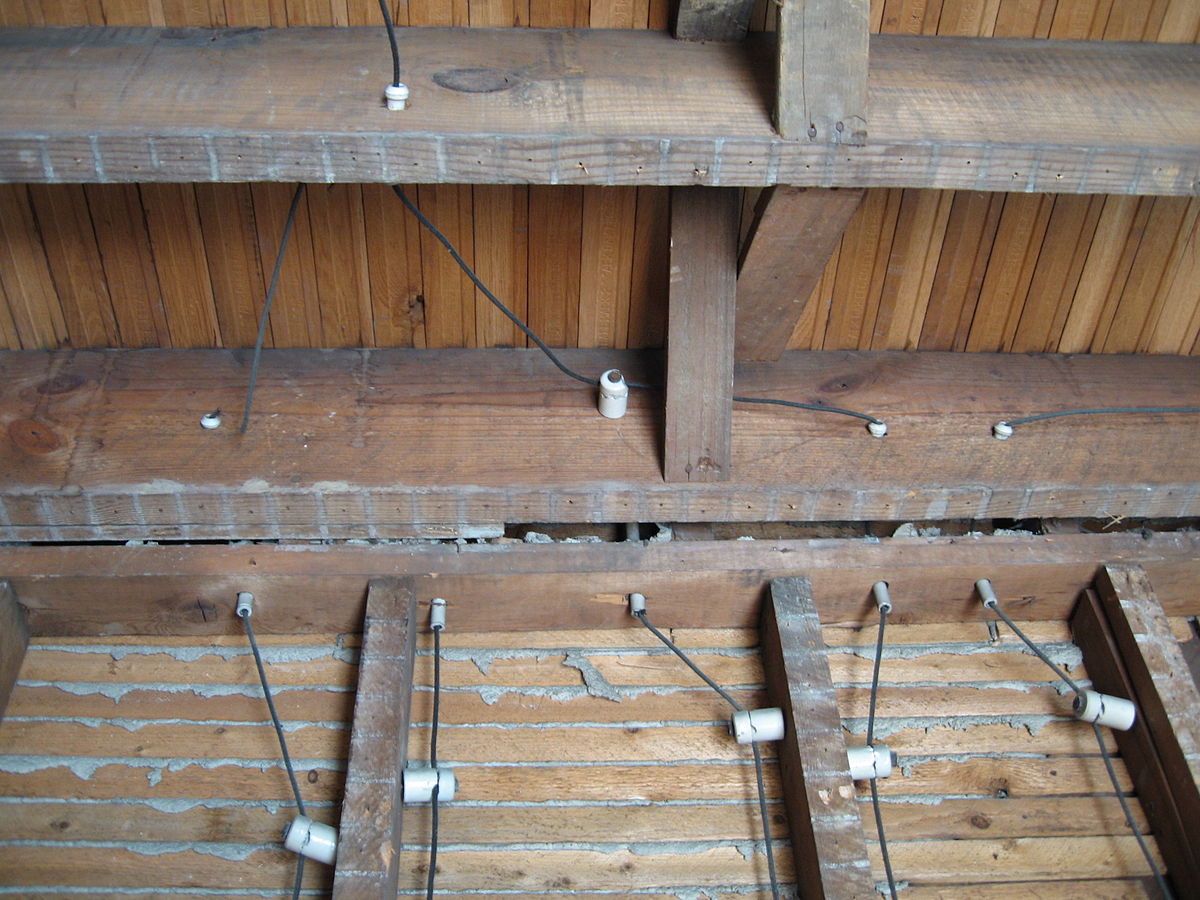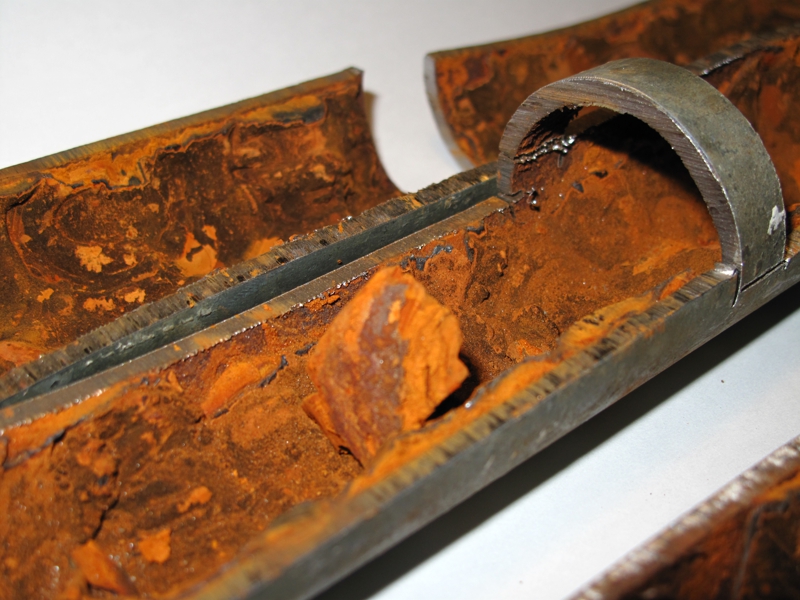Getting home insurance on older homes has never been easy, and it’s getting increasingly difficult as insurance companies have zero tolerance for antiquated systems (that are no longer to building code) that can cause major destruction to a property, such as fire or flood. A couple of these antiquated systems are knob and tube electrical wiring and galvanized plumbing.
Knob and Tube Wiring
Older houses often have what is called ‘knob and tube’ wiring. This wiring is considered dangerous by most insurance companies today, making it hard to insure homes and buildings that incorporate it. But why is it so dangerous that nobody wants to insure it? Is it something we should fear ourselves if our homes already have this type of wiring?
Dangers of Knob and Tube Wiring
Do you live in a home or commercial building that was built in the 1900’s to the early 1950’s? If so, then your building is almost sure to have what is called “knob and tube” wiring or a non grounded electrical system. Knob and tube wiring was considered “state-of-the-art” back then, but now it is very dangerous, is in violation of current legal electrical codes and is not insured by most insurance companies.
What’s so dangerous about knob and tube wiring? Let’s find out. Here are the top 5 dangers of knob and tube wiring.
- Knob and tube wiring is two-stranded – with a hot wire and a neutral wire only – it uses no ground wire. There is absolutely no protection whatsoever when a fault occurs. Shocks and fires can easily result.
- Knob and tube wiring uses a type of sheathing for insulation that, unfortunately, disintegrates over time. Since buildings that contain this type of wiring are old, the problem is compounded. Modern wiring uses much safer insulation materials.
- Older electrical systems use a 60 amp service but the circuits are have 15 amp fuses. This fuse can easily be replaced by a higher amp rated fuse which means that more current is flowing through the wire than it is meant to handle, leading to excessive heat and possible fire.
- Older electrical systems were not designed to carry high amperage loads and these extra loads cause the insulation to become brittle, exposing bare wire and the capacity to overheat which can cause fires.
- Older systems that use knob and tube wiring also use two-prong receptacles, restricting the use of small kitchen appliances. Since there is no ground wire, there is increased chance of shock and injury, especially around areas where water is prevalent. Kitchens and bathrooms are especially at risk.
If you have an older home or commercial building (built before 1950), it could be that you have knob and tube wiring installed. This poses a risk to you and your family or employees as well as your property. Most insurance companies do not insure buildings that contain this type of wiring.
Because of the dangers involved, we urge you to contact a licensed electrician to detect and correct all knob and tube wiring in your home or commercial business. If you are selling your home or business building, it’s expedient for you to have this issue fixed in advance because your buyer won’t be able to get insurance with knob and tube wiring in place. It’s best to get it replaced before you lose a potential sale.
How Do I Know if I Have Knob and Tube Wiring?
Inspect the visible parts of your home to see if you can find any knob and tube wiring. You won’t be able to look through the walls to see if any of this type of wiring is hidden underneath, but tube wiring is more predominant in the basement or the attic. Go up the stairs into your attic and follow the exposed wiring. You may have to clear out some insulation to do this as insulation often covers up wiring in the attic. Be careful not to step on any hidden wires as this can cause damage to them.
If you see wiring that is connected to little pieces of ceramic ‘knobs’, then you do have knob and tube wiring. Remember that this type of wiring uses two wires instead of three. These two are the hot wire and the return neutral wire; the ground wire is missing. Then go down into your basement and look for the same thing. In the basement, the wiring is often below the floorboards above. Since basements don’t often have a ceiling, you’ll be able to see the floorboards by simply looking up. If you see any ceramic connectors, linked with wires, you have knob and tube wiring. It is possible that wiring may be been removed, rending the ceramic knobs inactive.
 The attic and basement are not the only places knob and tube wiring can appear. Electrical wiring is hidden in the walls and ceilings of most houses and buildings, and you won’t be able to detect what type of wiring is hidden from view. In these cases, you’ll have to access the electrical box that houses your circuit breakers. We don’t advise you do this yourself because there are live wires within that box. If you do open your circuit box, be careful not to touch anything while the main power switch is on. Even if the main power switch is off, there are still live wires where the electricity enters the box. Never touch those wires unless the electric company itself has turned off all power to your home.
The attic and basement are not the only places knob and tube wiring can appear. Electrical wiring is hidden in the walls and ceilings of most houses and buildings, and you won’t be able to detect what type of wiring is hidden from view. In these cases, you’ll have to access the electrical box that houses your circuit breakers. We don’t advise you do this yourself because there are live wires within that box. If you do open your circuit box, be careful not to touch anything while the main power switch is on. Even if the main power switch is off, there are still live wires where the electricity enters the box. Never touch those wires unless the electric company itself has turned off all power to your home.
If you do decide to access your circuit box, look for wires coming in that only have two strands. There is a good chance that these wires use knob and tube wiring and have to be replaced. Our advice is to have to have a professional electrician inspect your home to make sure you don’t have any hidden two-strand wiring that is knob and tube. At the same time, the electrician will be able to give you a solid quote for replacing those dangerous circuits with new, modern circuits.
How Much Does it Cost to Replace Knob and Tube Wiring?
Call a qualified electrician to get an exact price on a complete home rewire. The charges include everything from running new circuits to replacing fuses with modern circuit breakers. It can be costly, but what price can be put on safety and peace of mind? You’ll rest much better knowing your wiring meets modern electrical codes for safety and performance.
A good contractor will patch the holes and the biggest hole you should see is the size of a baseball.
Plan to be ‘off the grid’ for a few hours or days while the work is being done. Electricians will need full access to your home or building and will have to shut off the power while they work. They may be able to confine this to only the circuits that have knob and tube wiring, but it depends on how that existing wiring has been done and whether additional circuits are needed or not. A good electrician will always brief you about these things so you know well in advance and can plan accordingly.
Is Insurance Available for Knob and Tube Wiring?
Most insurance companies refuse to cover homes with knob and tube wiring in place because it does not have a ground wire. If you can’t get insurance, you can’t get a mortgage, so it’s a good idea to find out if a house or building has any knob and tube wiring before making a purchase option.
One thing that can be done to increase the safety of knob and tube wiring is to add a ground fault circuit breaker to any circuit that has this tube type of wiring on it. This type of circuit breaker adds a ground loop right at the circuit box. It was designed exactly for this type of two-wire circuit.
If you can’t get insurance on a home or building that has knob and tube wiring, your best bet is to replace the wiring. It will increase your safety and give you better peace of mind. If you are making an offer on a home or building that is affected, it’s in the interest of the selling party to have this wire replaced immediately so as not to hinder the sale of the property. If people can’t get insurance for the property, the sale won’t go through.
Getting insurance for it can be difficult and the cost will likely be more. If the knob and tube wiring is active, most insurance companies will require that it be removed prior to closing or 30 days after closing.
How to Replace Knob and Tube Wiring
An expert should inspect the condition of the wires, connections and devices like receptacles, switches, and over current protection by fuses or circuit breakers. Be very careful replacing knob and tube wiring! This is not a job for the novice home-electrician.
Ground fault protection (GFCI circuit protection and possibly arc fault protection) can be added on two-wire un-grounded electrical circuits to reduce the chances of electrical shock or fire. You can do this by replacing the existing circuit breaker with a GFCI circuit breaker. They cost a bit more, but they solve the problem of not having a ground wire in two-wire situations like where tube wiring is used.
To find knob and tube wiring, make visual inspection of the entire building to identify where knob and tube wiring is visible. Then trace those circuits as far as you can into individual rooms. Use instruments (such as the Tic Tracer that senses electrical wires in walls) to trace down wiring paths in walls, ceilings, floors.
When you find knob and tube wiring, you have two choices. The first choice is the most often used, and that is to simply leave the wiring in place and run a new circuit. It’s used the most often because it’s easiest, and the remaining wiring is harmless since it won’t be reconnect it to the power source.
The second choice is to pull out that old wiring and replace it with new wiring. This takes longer and can be harder, especially if there are ceramic insulators embedded in wood. It’s better to just leave them as is and run a new circuit.
Most electrical contractors recommend replacing knob and tube wiring with modern wiring. Even though there are costs involved, having the peace of mind, knowing your electrical system meets the modern electrical code for safety, goes a long way. Consult your local electrician to find out if you have knob and tube wiring and to get a quote on the cost to replace it. In the long run, you’ll be glad you did.
Galvanized Steel Plumbing
Interesting factoid from Wikipedia: Galvanization is the process of applying a protective zinc coating to steel or iron, in order to prevent rusting. The term is derived from the name of Italian scientist Luigi Galvani.
 Galvanized steel pipes, commonly installed in homes prior to 1950 (some sites say it was used until the 1960s), have an average life expectancy of 40 to 50 years. Over time, the galvanized steel pipes begin to rust or corrode from the inside out, resulting in reduced water pressure and restricted water flow. This presents an increased risk of leaks or ruptures occurring in the pipes and the potential for flood damage. Corrosion also occurs to steel when it is connected directly to copper or brass. Insurance companies may require replacement of galvanized steel piping with copper and plastic piping before providing coverage.
Galvanized steel pipes, commonly installed in homes prior to 1950 (some sites say it was used until the 1960s), have an average life expectancy of 40 to 50 years. Over time, the galvanized steel pipes begin to rust or corrode from the inside out, resulting in reduced water pressure and restricted water flow. This presents an increased risk of leaks or ruptures occurring in the pipes and the potential for flood damage. Corrosion also occurs to steel when it is connected directly to copper or brass. Insurance companies may require replacement of galvanized steel piping with copper and plastic piping before providing coverage.
What kind of pipes does your home have?
There is an easy way to check. Find where your piping enters your home and then scratch it. If your piping is:
- Copper, the scratched area will have the look of a copper penny.
- Galvanized steel, the scratched area will be a silver-gray color.
- Plastic, which is usually black in color, you will be able to see a clamp where it is joined to the water supply piping.
Replacing galvanized steel pipes
You can tell if galvanized steel pipes are going to give you water pressure problems before they completely fail. If rust growth is spotted on the exterior of the pipes, you will probably encounter leaking problems within a year or so.
Watch for these signs:
- Rust around your pipe joints and pitted rust spots on your pipes.
- Brownish water coming out of your faucets – Rust can end up in the water itself. This will be obvious if the water appears brownish or rusty coloured after it has been left off for a long period. This is due to the water sitting in the pipe long enough to accumulate enough rust to make itself visible to the naked eye.
- Lower-than-usual water pressure as the pipes internal diameter becomes narrower due to imposing calcium build up, the water has a much smaller path to traverse. This restricted flow reveals itself as lowered water pressure since there is simply not enough water making it through to access the demands placed upon it. The only way to remedy this problem is to completely replace the galvanized plumbing that has been affected.
How do galvanized pipes fail?
The pipes rust away from the inside out, causing weak structural properties causing leaks and collapses. They will also develop calcium deposits inside of the pipe. These pipes can eventually become completely clogged with calcium build up resulting in low water pressure and rusty water.

